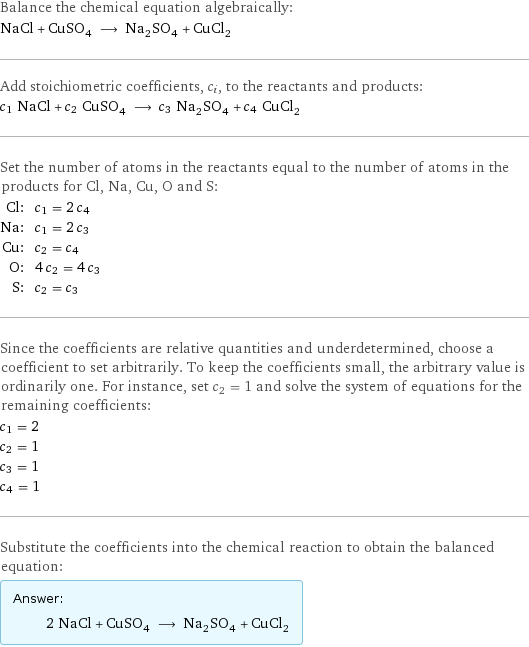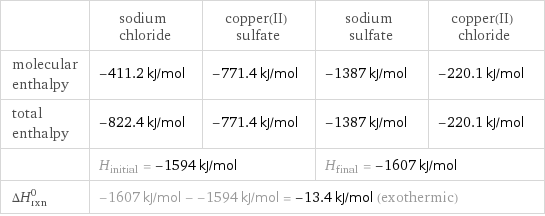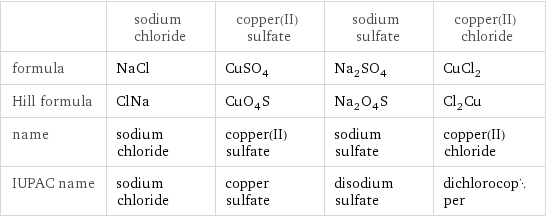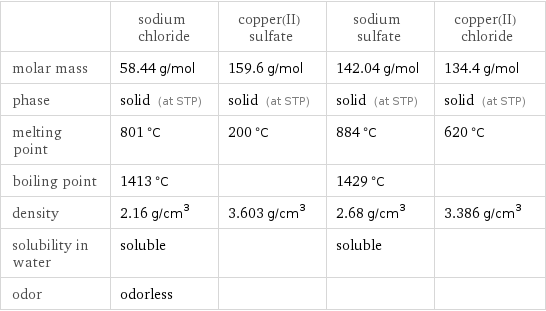Input interpretation

NaCl sodium chloride + CuSO_4 copper(II) sulfate ⟶ Na_2SO_4 sodium sulfate + CuCl_2 copper(II) chloride
Balanced equation

Balance the chemical equation algebraically: NaCl + CuSO_4 ⟶ Na_2SO_4 + CuCl_2 Add stoichiometric coefficients, c_i, to the reactants and products: c_1 NaCl + c_2 CuSO_4 ⟶ c_3 Na_2SO_4 + c_4 CuCl_2 Set the number of atoms in the reactants equal to the number of atoms in the products for Cl, Na, Cu, O and S: Cl: | c_1 = 2 c_4 Na: | c_1 = 2 c_3 Cu: | c_2 = c_4 O: | 4 c_2 = 4 c_3 S: | c_2 = c_3 Since the coefficients are relative quantities and underdetermined, choose a coefficient to set arbitrarily. To keep the coefficients small, the arbitrary value is ordinarily one. For instance, set c_2 = 1 and solve the system of equations for the remaining coefficients: c_1 = 2 c_2 = 1 c_3 = 1 c_4 = 1 Substitute the coefficients into the chemical reaction to obtain the balanced equation: Answer: | | 2 NaCl + CuSO_4 ⟶ Na_2SO_4 + CuCl_2
Structures

+ ⟶ +
Names

sodium chloride + copper(II) sulfate ⟶ sodium sulfate + copper(II) chloride
Reaction thermodynamics
Enthalpy

| sodium chloride | copper(II) sulfate | sodium sulfate | copper(II) chloride molecular enthalpy | -411.2 kJ/mol | -771.4 kJ/mol | -1387 kJ/mol | -220.1 kJ/mol total enthalpy | -822.4 kJ/mol | -771.4 kJ/mol | -1387 kJ/mol | -220.1 kJ/mol | H_initial = -1594 kJ/mol | | H_final = -1607 kJ/mol | ΔH_rxn^0 | -1607 kJ/mol - -1594 kJ/mol = -13.4 kJ/mol (exothermic) | | |
Gibbs free energy

| sodium chloride | copper(II) sulfate | sodium sulfate | copper(II) chloride molecular free energy | -384.1 kJ/mol | -662.2 kJ/mol | -1270 kJ/mol | -175.7 kJ/mol total free energy | -768.2 kJ/mol | -662.2 kJ/mol | -1270 kJ/mol | -175.7 kJ/mol | G_initial = -1430 kJ/mol | | G_final = -1446 kJ/mol | ΔG_rxn^0 | -1446 kJ/mol - -1430 kJ/mol = -15.5 kJ/mol (exergonic) | | |
Equilibrium constant
![Construct the equilibrium constant, K, expression for: NaCl + CuSO_4 ⟶ Na_2SO_4 + CuCl_2 Plan: • Balance the chemical equation. • Determine the stoichiometric numbers. • Assemble the activity expression for each chemical species. • Use the activity expressions to build the equilibrium constant expression. Write the balanced chemical equation: 2 NaCl + CuSO_4 ⟶ Na_2SO_4 + CuCl_2 Assign stoichiometric numbers, ν_i, using the stoichiometric coefficients, c_i, from the balanced chemical equation in the following manner: ν_i = -c_i for reactants and ν_i = c_i for products: chemical species | c_i | ν_i NaCl | 2 | -2 CuSO_4 | 1 | -1 Na_2SO_4 | 1 | 1 CuCl_2 | 1 | 1 Assemble the activity expressions accounting for the state of matter and ν_i: chemical species | c_i | ν_i | activity expression NaCl | 2 | -2 | ([NaCl])^(-2) CuSO_4 | 1 | -1 | ([CuSO4])^(-1) Na_2SO_4 | 1 | 1 | [Na2SO4] CuCl_2 | 1 | 1 | [CuCl2] The equilibrium constant symbol in the concentration basis is: K_c Mulitply the activity expressions to arrive at the K_c expression: Answer: | | K_c = ([NaCl])^(-2) ([CuSO4])^(-1) [Na2SO4] [CuCl2] = ([Na2SO4] [CuCl2])/(([NaCl])^2 [CuSO4])](../image_source/3d284c991dc1b1c0cd596ce7e60980ec.png)
Construct the equilibrium constant, K, expression for: NaCl + CuSO_4 ⟶ Na_2SO_4 + CuCl_2 Plan: • Balance the chemical equation. • Determine the stoichiometric numbers. • Assemble the activity expression for each chemical species. • Use the activity expressions to build the equilibrium constant expression. Write the balanced chemical equation: 2 NaCl + CuSO_4 ⟶ Na_2SO_4 + CuCl_2 Assign stoichiometric numbers, ν_i, using the stoichiometric coefficients, c_i, from the balanced chemical equation in the following manner: ν_i = -c_i for reactants and ν_i = c_i for products: chemical species | c_i | ν_i NaCl | 2 | -2 CuSO_4 | 1 | -1 Na_2SO_4 | 1 | 1 CuCl_2 | 1 | 1 Assemble the activity expressions accounting for the state of matter and ν_i: chemical species | c_i | ν_i | activity expression NaCl | 2 | -2 | ([NaCl])^(-2) CuSO_4 | 1 | -1 | ([CuSO4])^(-1) Na_2SO_4 | 1 | 1 | [Na2SO4] CuCl_2 | 1 | 1 | [CuCl2] The equilibrium constant symbol in the concentration basis is: K_c Mulitply the activity expressions to arrive at the K_c expression: Answer: | | K_c = ([NaCl])^(-2) ([CuSO4])^(-1) [Na2SO4] [CuCl2] = ([Na2SO4] [CuCl2])/(([NaCl])^2 [CuSO4])
Rate of reaction
![Construct the rate of reaction expression for: NaCl + CuSO_4 ⟶ Na_2SO_4 + CuCl_2 Plan: • Balance the chemical equation. • Determine the stoichiometric numbers. • Assemble the rate term for each chemical species. • Write the rate of reaction expression. Write the balanced chemical equation: 2 NaCl + CuSO_4 ⟶ Na_2SO_4 + CuCl_2 Assign stoichiometric numbers, ν_i, using the stoichiometric coefficients, c_i, from the balanced chemical equation in the following manner: ν_i = -c_i for reactants and ν_i = c_i for products: chemical species | c_i | ν_i NaCl | 2 | -2 CuSO_4 | 1 | -1 Na_2SO_4 | 1 | 1 CuCl_2 | 1 | 1 The rate term for each chemical species, B_i, is 1/ν_i(Δ[B_i])/(Δt) where [B_i] is the amount concentration and t is time: chemical species | c_i | ν_i | rate term NaCl | 2 | -2 | -1/2 (Δ[NaCl])/(Δt) CuSO_4 | 1 | -1 | -(Δ[CuSO4])/(Δt) Na_2SO_4 | 1 | 1 | (Δ[Na2SO4])/(Δt) CuCl_2 | 1 | 1 | (Δ[CuCl2])/(Δt) (for infinitesimal rate of change, replace Δ with d) Set the rate terms equal to each other to arrive at the rate expression: Answer: | | rate = -1/2 (Δ[NaCl])/(Δt) = -(Δ[CuSO4])/(Δt) = (Δ[Na2SO4])/(Δt) = (Δ[CuCl2])/(Δt) (assuming constant volume and no accumulation of intermediates or side products)](../image_source/906a95c3c15d3f02e060a703f7212db1.png)
Construct the rate of reaction expression for: NaCl + CuSO_4 ⟶ Na_2SO_4 + CuCl_2 Plan: • Balance the chemical equation. • Determine the stoichiometric numbers. • Assemble the rate term for each chemical species. • Write the rate of reaction expression. Write the balanced chemical equation: 2 NaCl + CuSO_4 ⟶ Na_2SO_4 + CuCl_2 Assign stoichiometric numbers, ν_i, using the stoichiometric coefficients, c_i, from the balanced chemical equation in the following manner: ν_i = -c_i for reactants and ν_i = c_i for products: chemical species | c_i | ν_i NaCl | 2 | -2 CuSO_4 | 1 | -1 Na_2SO_4 | 1 | 1 CuCl_2 | 1 | 1 The rate term for each chemical species, B_i, is 1/ν_i(Δ[B_i])/(Δt) where [B_i] is the amount concentration and t is time: chemical species | c_i | ν_i | rate term NaCl | 2 | -2 | -1/2 (Δ[NaCl])/(Δt) CuSO_4 | 1 | -1 | -(Δ[CuSO4])/(Δt) Na_2SO_4 | 1 | 1 | (Δ[Na2SO4])/(Δt) CuCl_2 | 1 | 1 | (Δ[CuCl2])/(Δt) (for infinitesimal rate of change, replace Δ with d) Set the rate terms equal to each other to arrive at the rate expression: Answer: | | rate = -1/2 (Δ[NaCl])/(Δt) = -(Δ[CuSO4])/(Δt) = (Δ[Na2SO4])/(Δt) = (Δ[CuCl2])/(Δt) (assuming constant volume and no accumulation of intermediates or side products)
Chemical names and formulas

| sodium chloride | copper(II) sulfate | sodium sulfate | copper(II) chloride formula | NaCl | CuSO_4 | Na_2SO_4 | CuCl_2 Hill formula | ClNa | CuO_4S | Na_2O_4S | Cl_2Cu name | sodium chloride | copper(II) sulfate | sodium sulfate | copper(II) chloride IUPAC name | sodium chloride | copper sulfate | disodium sulfate | dichlorocopper
Substance properties

| sodium chloride | copper(II) sulfate | sodium sulfate | copper(II) chloride molar mass | 58.44 g/mol | 159.6 g/mol | 142.04 g/mol | 134.4 g/mol phase | solid (at STP) | solid (at STP) | solid (at STP) | solid (at STP) melting point | 801 °C | 200 °C | 884 °C | 620 °C boiling point | 1413 °C | | 1429 °C | density | 2.16 g/cm^3 | 3.603 g/cm^3 | 2.68 g/cm^3 | 3.386 g/cm^3 solubility in water | soluble | | soluble | odor | odorless | | |
Units
